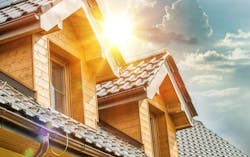The last eight years have been the hottest on record, and according to the World Meteorological Organization, 2023 is on track to be the single hottest year in earth’s history. Extreme heat doesn’t just affect our physical and mental well-being; when it comes to the built environment, heat can also have an impact on occupant safety and the longevity of existing homes.
Excessive heat has the most significant impact on a home’s roof, air conditioning system, and wood surfaces. But there are a few adaptive design strategies that can protect those building components during potentially dangerous heat waves. According to Forbes, “cool roofs” and “cool walls” are designed to reflect sunlight and absorb less heat to reduce the ambient temperature of indoor and outdoor spaces. In addition, simple changes such as replacing air conditioner filters and using shades or blackout curtains can help to keep homes cool, even during record-high temperatures.
“High temperatures can increase the rate of wear on building materials such as facades and roofs, accelerating deterioration and the need for repair or replacement,” shared [Lindsay] Brugger. (Humidity can add mold and mildew risk.)
[Corbin] Clay agreed: “Extreme heat can drastically increase a home’s maintenance needs and costs. The additional energy needed to cool your home will result in higher electricity bills, and exterior finishes and materials will fail prematurely. These will need to be maintained more often (like exterior paint and caulking), and surfaces that should last for decades like your roof, asphalt driveways, and wood decking will likewise need to be replaced much sooner. With regard to your roof, “Once temperatures cool in the fall, it’s a good idea to have [it] inspected to ensure everything is still water-tight,” he suggested.
